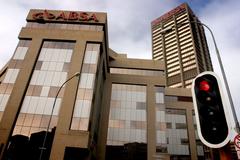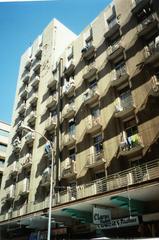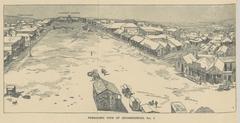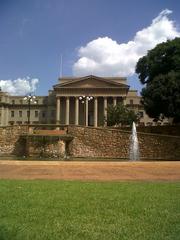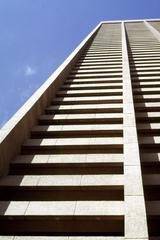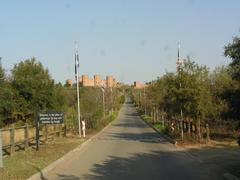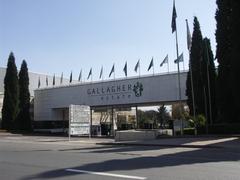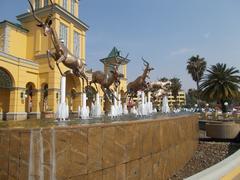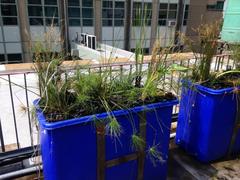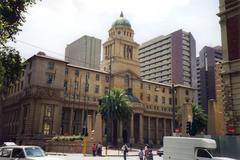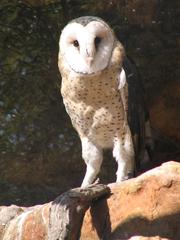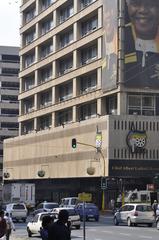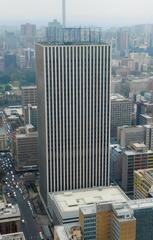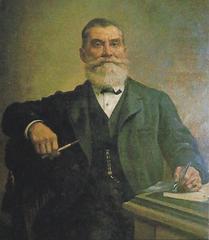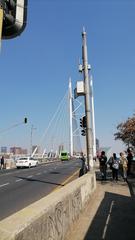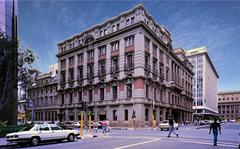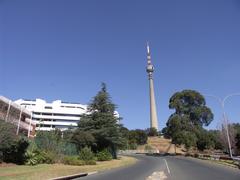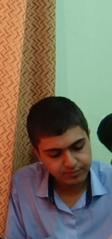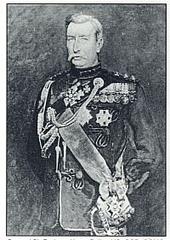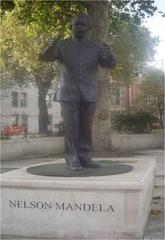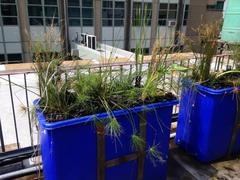Radiopark Johannesburg Visiting Hours, Tickets, and Travel Guide
Date: 14/06/2025
Radiopark, an iconic skyscraper in Auckland Park, Johannesburg, stands as a powerful symbol of South Africa’s broadcasting history and urban evolution. This comprehensive guide is designed to equip visitors with detailed insights into Radiopark’s architectural and cultural significance, practical visiting information, and tips for exploring the surrounding area.
Table of Contents
- Introduction
- Historical Background
- Architectural Significance
- Visiting Radiopark
- Nearby Attractions
- Travel Tips
- Frequently Asked Questions (FAQ)
- Conclusion & Final Tips
- Sources and Further Reading
Introduction
Radiopark, also known as the Radio Park Building, rises above the Auckland Park suburb as a testament to South Africa’s broadcasting legacy and modernist architecture (Wikipedia). Commissioned by the South African Broadcasting Corporation (SABC) in the late 1960s and officially opened in the early 1970s, Radiopark centralized and modernized national radio and television operations during a period of significant technological advancement and sociopolitical change (gov.za). Today, the building continues to shape the nation’s media landscape, while its striking concrete form remains a prominent feature of Johannesburg’s skyline (Skyscraper Center; Traveloka).
Historical Background
Origins and Construction
Radiopark was developed to consolidate the SABC’s operations, symbolizing the country’s embrace of modern broadcasting technology. Constructed by Murray & Roberts (now Concor Construction) and designed by Vennootskap Daan Kesting, the building was completed in the late 1970s and officially opened in 1972 (Wikipedia). Standing 150.9 meters tall with 33 floors, it quickly became one of Johannesburg’s most recognizable skyscrapers.
Role in Johannesburg’s Development
The building’s completion transformed Auckland Park from a quiet suburb into a vibrant media and academic hub, joining neighbors like the University of Johannesburg and stimulating the growth of surrounding districts (Mapcarta). Its location at 35 Henley Road ensures easy access via major transport routes and proximity to trendy suburbs such as Melville and Parktown.
Radiopark and the SABC
During apartheid, Radiopark centralized SABC’s operations, housing radio studios, technical facilities, and administrative offices. Its design projected authority while facilitating state control of media. In the post-apartheid era, SABC’s mission shifted toward inclusivity and diversity, with Radiopark remaining a core site for multilingual and multicultural broadcasting (bbc.com).
Architectural Significance
Radiopark exemplifies late-modernist architecture with its robust concrete structure, clean lines, and rational design (EAA Architecture Guide). The building’s verticality and repetitive window patterns are hallmarks of the international style, while its functional amenities—soundproof studios, technical infrastructure—reflect the specialized needs of a national broadcaster.
Within Johannesburg’s cityscape, Radiopark stands alongside other modernist icons like the Carlton Centre and Hillbrow Tower (Kurby Blog). Its ongoing use by the SABC has ensured its preservation and continued relevance, distinguishing it from many modernist buildings that have fallen into disrepair.
Visiting Radiopark
Visiting Hours and Access
Radiopark is primarily an operational broadcasting facility and is not open to walk-in public tours. However, the building’s dramatic exterior can be admired and photographed from public areas daily, typically from 7:00 AM to 7:00 PM.
Guided tours of the facility—featuring visits to radio studios, technical areas, and archives—are occasionally available by advance appointment, especially for educational groups and media professionals. For up-to-date information on tour schedules and availability, contact the SABC directly or check with authorized tour operators (Traveloka).
Tickets and Tours
- Exterior viewing: Free, no ticket required.
- Guided tours: Usually free or low-cost, but must be booked at least two weeks in advance via the SABC website or Radiopark reception. A nominal, refundable deposit may be requested depending on group size or event status (GetYourGuide).
Accessibility
Radiopark is equipped with elevators, ramps, and accessible restrooms to accommodate visitors with disabilities. If you require special assistance during a tour, inform the SABC when booking.
The surrounding area is pedestrian-friendly, and public transport options such as Rea Vaya buses, taxis, and ride-hailing services are readily available. Parking is nearby but can be limited.
Visitor Tips
- Best time to visit: Weekdays during daylight for optimal viewing and safety.
- Combine your visit: Pair Radiopark with nearby cultural or historical sites for a full day out.
- Respect the facility: Radiopark is a working building. Do not attempt to enter unauthorized areas.
- Photography: Permitted outside; interior photography is restricted and only possible by prior arrangement during guided tours.
Nearby Attractions
Radiopark’s strategic Auckland Park location makes it an ideal starting point for exploring Johannesburg:
- University of Johannesburg: Vibrant campus and student culture.
- Brixton Tower: Offers panoramic city views.
- Fietas Museum: Chronicles Johannesburg’s multicultural neighborhoods.
- Melville & Parktown: Trendy cafés, restaurants, and historic homes.
- Constitution Hill: Former prison, now home to South Africa’s Constitutional Court (Rough Guides).
- Johannesburg Art Gallery: Extensive art collections.
- Maboneng Precinct: Renowned for street art, galleries, and markets (The Broke Backpacker).
- Apartheid Museum: Comprehensive documentation of South Africa’s segregation history.
- Melville Koppies Nature Reserve: Offers hiking trails and city views.
Travel Tips
- Transport: Use ride-hailing services (Uber, Bolt) or taxis for convenience and safety, especially after dark. The area is accessible via Rea Vaya BRT and main roads (Boundless Journeys).
- Safety: Exercise urban awareness, especially when walking after dark.
- Weather: June is winter in Johannesburg, with daytime temperatures between 8°C and 18°C, and dry, mild conditions—ideal for sightseeing (Weather25).
- Facilities: Restrooms and cafés available at the SABC canteen and in nearby Melville.
- Money: South African Rand (ZAR) is the currency; cards are widely accepted, but carry some cash.
Frequently Asked Questions (FAQ)
Q: Can visitors enter Radiopark?
A: Interior access is restricted to guided tours and special events by appointment. The exterior is freely viewable from public spaces.
Q: Are tours free?
A: Most tours are free or low-cost but require advance booking.
Q: How do I book a tour?
A: Book directly via the SABC website or through authorized tour operators.
Q: Is Radiopark accessible for people with disabilities?
A: Yes, with elevators, ramps, and accessible restrooms. Notify staff of specific needs when booking.
Q: Are there other attractions nearby?
A: Yes—University of Johannesburg, Constitution Hill, Apartheid Museum, Melville, Maboneng, and more.
Q: Is photography allowed?
A: Outside, yes. Inside, only by arrangement during tours.
Conclusion & Final Tips
Radiopark stands as a monument to Johannesburg’s journey from the apartheid era to modern democracy, reflecting South Africa’s ambitions, challenges, and ongoing transformation (Wikipedia; gov.za). While general public access is limited, its architectural significance and proximity to some of the city’s top cultural sites make it a must-see for anyone interested in media, history, or urban design (bbc.com; Traveloka). For a richer experience, pair your visit with guided tours and explorations of nearby attractions.
To stay updated on tours, events, and Johannesburg’s cultural offerings, consult official SABC resources and local tourism websites. For audio guides and insider tips, download the Audiala app.
Sources and Further Reading
- This article draws on the following sources for factual accuracy and visitor information:
- Wikipedia
- Broadcasting Policy Green Paper, gov.za
- BBC News: South Africa Media Profile
- Skyscraper Center: Radio Park Building
- Kurby Blog: Johannesburg Architecture
- In Africa and Beyond: Things to Do in Johannesburg
- Traveloka: Radiopark Studios
- Rough Guides: Johannesburg Weather and Travel Tips
- The Broke Backpacker: Best Places to Visit in Johannesburg
- Boundless Journeys: Johannesburg City Guide
Plan your visit to Radiopark and discover the intersection of South Africa’s media, architecture, and vibrant urban culture. For more travel insights, download the Audiala app and follow us on social media.

